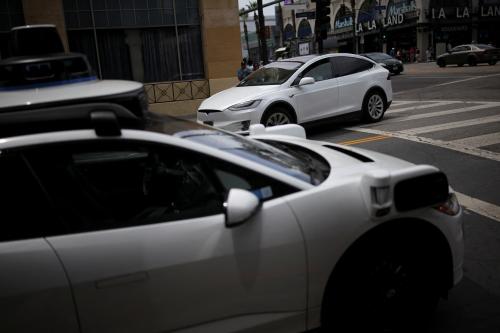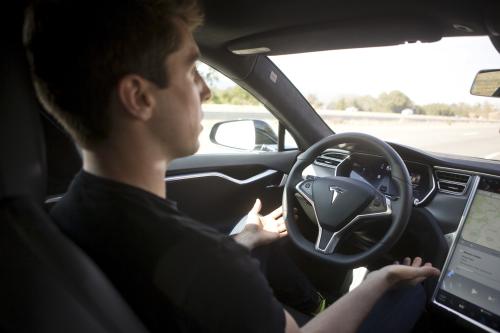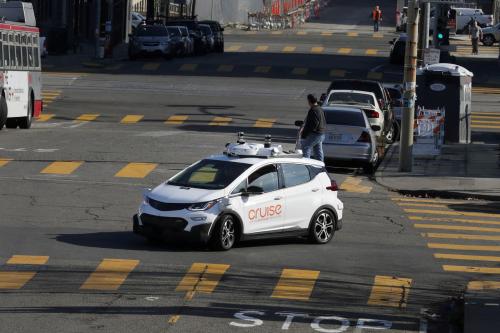After many years of delays, self-driving cars, trucks, and buses are appearing on the roads of major American cities. There are currently autonomous taxis in Phoenix, San Francisco, and Austin, and self-driving trucks in Texas. Washington, D.C. is also testing the vehicles, and it will be interesting to see how they navigate the city’s complicated traffic circles.
As these vehicles become more ubiquitous, though, questions are emerging about how they will reshape urban design and operations —and what cities should do to fully leverage the technology. These new forms of transportation are poised to transform city life and require changes to city streets and traffic infrastructure, but with the right adjustments, autonomous driving could make urban travel safer, faster, and cleaner.
Reduce accidents and fatalities
Around 40,000 people die in traffic accidents each year in America, and roughly 90% of the fatalities are due to human error. People make mistakes because of drunk driving, tiredness, phone usage, or other factors that take their eyes off the road.
Autonomous vehicles have caused accidents, including fatal ones, due to issues like solar glare, camera malfunctions, software errors, and hardware failures. However, these risks are expected to cause far fewer deaths than those tied to human intoxication, exhaustion, or distraction. For all their possible flaws, computer-driven vehicles don’t get drunk, tired, or distracted, and as they become more common, the overall human toll on the roads is likely to drop significantly.
Decrease levels of vehicle ownership
We already are seeing significant drops in vehicle ownership in urban areas, especially among young people. Many people living in central cities are unlikely to own vehicles, relying instead on ride-sharing services or taxis to meet their transportation needs. Autonomous vehicles are expected to accelerate this shift away from car ownership, helping to reduce traffic congestion and lessen the environmental impact of cars and trucks in major metropolitan areas.
As car ownership declines, cities will need fewer parking lots, gas stations, and even streets. In turn, urban planners will be able to shift their focus away from car-centric design and toward human-centered spaces like parks, pedestrian walkways, bike lanes, and entertainment zones.
Redesign streets for bikes, autonomous delivery, and commuting
With an increase in the number of autonomous cars, trucks, and buses, urban leaders can redesign streets for bikes, autonomous delivery, and commuting. There may be less need for streets in their traditional sense, allowing cities to think about urban designs featuring dedicated areas for autonomous vehicles and automated delivery systems or amenities such as bike lanes.
Streets could include designated cutouts for delivery vehicles, preventing vans and trucks from blocking traffic as they often do today. Without proper parking, deliveries frequently disrupt traffic flow, frustrating drivers and slowing commutes. By giving delivery vehicles a place to pull aside, cities could reduce congestion and make driving more efficient and pleasant.
Install dynamic traffic lights
Most cities today use static traffic lights that change on fixed timers, regardless of actual traffic conditions. As a result, drivers often sit at red lights even when no cross traffic is present. By integrating road sensors or using data from navigational systems that already track vehicle locations, cities could adopt dynamic traffic lights that adjust in real time. These smart signals would improve traffic flow and offer a more efficient, convenient alternative to current static models.
Open pedestrian walkways and entertainment zones
Autonomous vehicles will create opportunities to redesign cities with pedestrians—not cars—as the central focus. Contemporary cities devote vast amounts of space to streets, parking, gas stations and auto repair businesses. But with fewer personally owned vehicles and increased reliance on autonomous vehicles, city planners can explore more creative layouts that prioritize walkways, malls, and entertainment zones. These redesigned spaces could feature designated pickup and drop-off points for autonomous vehicles and ride-sharing services, reducing the need for expansive roadways and parking lots.
Reduce the importance of distance
In cities with widespread autonomous vehicle use, distance may become less of a barrier than it is today. Much like the expansion of railroads and subways once allowed people to move farther from city centers, autonomous vehicles could make long commutes more tolerable by transforming driving into a passive experience. Instead of battling traffic, passengers could work, relax with a movie, or connect with loved ones on the phone—arriving home refreshed as opposed to angry and exhausted. This shift could expand commuting zones and reduce the necessity of living in central urban areas.
Retrain drivers for other jobs
As autonomous technology gains steam, the demand for human drivers of trucks, taxis and ride-sharing services will decline. Cities will need to figure out how to retrain these workers for new jobs. Entry-level positions in taxi driving and ride-sharing will likely disappear, and urban leaders must ensure that transportation-sector workers aren’t left behind as this aspect of the digital revolution unfolds.
Use public education campaigns to increase public confidence in autonomy
Autonomy is advancing rapidly, and city planners must consider how the rise of self-driving cars and trucks will impact city operations, urban planning, and metropolitan design. They should recognize that past approaches will likely require significant revisions and develop new planning models that reflect these emerging transportation changes.
At the same time, leaders should work to increase public confidence in autonomous systems. Even though research demonstrates that autonomous vehicles are safer and cleaner than human-operated ones, many people remain wary and are reluctant to ride in them. A 2018 Brookings survey found that only 21% of Americans were willing to ride in autonomous vehicles, with many opposed citing safety and security concerns. As cities adopt these technologies, public education campaigns will be essential to address skepticism and reassure people about the safety and reliability of autonomous transportation.
Plan for unknown unknowns
As is often the case, there will be “unknown unknowns” that we cannot anticipate. When automobiles first appeared in cities, Tom Standage notes in “A Brief History of Motion” that New York City had over 150,000 horses, each producing about 22 pounds of manure and a quart of urine daily. Cars were considered “clean energy” compared to the waste produced by their equestrian predecessors. Eventually, as the number of cars grew into the millions, their internal combustion engines created severe air pollution that required government intervention. City planners should expect some unexpected costs and benefits from autonomous vehicles and remain flexible in how they plan the future. The rule of unanticipated consequences will likely produce some surprises for urban leaders.
The Brookings Institution is committed to quality, independence, and impact.
We are supported by a diverse array of funders. In line with our values and policies, each Brookings publication represents the sole views of its author(s).








Commentary
How autonomous vehicles could change cities
May 20, 2025